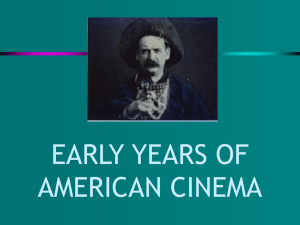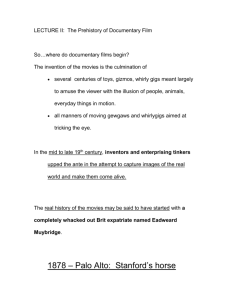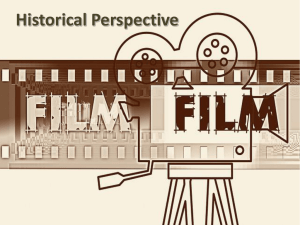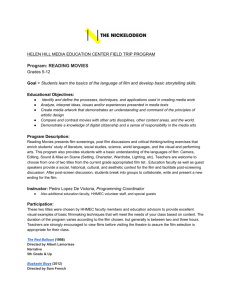THE AMERICAN SILENT ERA: INVENTION & INNOVATION
advertisement
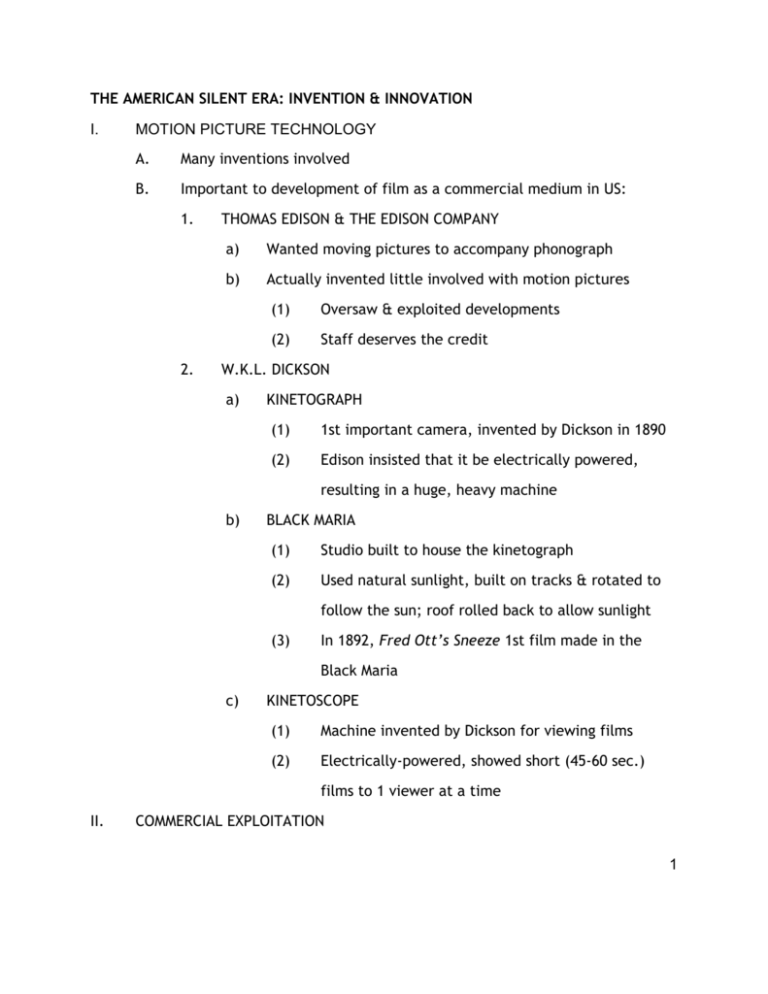
THE AMERICAN SILENT ERA: INVENTION & INNOVATION I. MOTION PICTURE TECHNOLOGY A. Many inventions involved B. Important to development of film as a commercial medium in US: 1. 2. THOMAS EDISON & THE EDISON COMPANY a) Wanted moving pictures to accompany phonograph b) Actually invented little involved with motion pictures (1) Oversaw & exploited developments (2) Staff deserves the credit W.K.L. DICKSON a) KINETOGRAPH (1) 1st important camera, invented by Dickson in 1890 (2) Edison insisted that it be electrically powered, resulting in a huge, heavy machine b) BLACK MARIA (1) Studio built to house the kinetograph (2) Used natural sunlight, built on tracks & rotated to follow the sun; roof rolled back to allow sunlight (3) In 1892, Fred Ott’s Sneeze 1st film made in the Black Maria c) KINETOSCOPE (1) Machine invented by Dickson for viewing films (2) Electrically-powered, showed short (45-60 sec.) films to 1 viewer at a time II. COMMERCIAL EXPLOITATION 1 A. KINETOSCOPE PARLORS 1. In 1894, Edison contracted with Raff & Gammon, which opened kinetoscope parlors in NYC B. III. 2. Charged 25c for admission 3. Made $ 1st year, by 1895 lost $ due to cost of maintenance THOMAS ARMAT & THE VITASCOPE 1. 1895, Armat developed primitive film projector 2. Edison bought & manufactured it 3. Premiered in NY at Koster & Bial’s Music Hall in 1896 4. Then distributed throughout the US EDISON’S COMPETITORS A. Cheap & easy to make equipment & films; many companies established after Edison B. C. IV. 1. Established in 1896 by Dickson, who had left the Edison 2. Well-financed (Rockefeller $) 3. Used a more mobile, hand-cranked camera Early film industry truly competitive, many small companies THE NICKELODEON ERA A. V. Most important was BIOGRAPH Exhibition has gone through 3 broad stages: 1. NICKELODEON ERA established base audience 2. PICTURE PALACE ERA symbolizes Hollywood’s “Golden Age” 3. SHOPPING MALL MULTIPLEX typifies film exhibition today THE NICKELODEON ERA (1905-1915) A. ORIGIN 2 1. In 1905 boom began, filmgoing became a popular activity, especially in urban ghettos B. C. D. E. 2. Nickelodeon Theater opened in Pittsburgh 3. All small theaters came to be known as “nickelodeons” GROWTH 1. Spread quickly; by 1910, 10,000 2. Audience almost exclusively working class DESCRIPTION 1. Admission price 10c 2. Small converted storefronts, in working class neighborhoods 3. Accommodated 50-100 people 4. Piano player, interpreter in ethnic neighborhoods PROGRAM 1. About 1 hr. long, 3 short films (10 min. each), vaudeville acts 2. Mostly French slapstick comedies 3. Program changed 2-3 times per week PATRONS 1. Called “Democracy’s Theater,” supported by working class 2. Ticket prices of available entertainment: a) Opera & Theater $2.00 Upper class b) Good Vaudeville .50 Middle class c) Bad Vaudeville .15 d) Nickelodeon .10 Working class “ “ 3. Average income of a working-class family $12-15 per week 4. CHANGE FROM WORKING CLASS TO MIDDLE CLASS 3 a) By 1912 theater owners began to seek prestige, more $; tried to attract a higher-class audience (1) Special rates to women & children (2) Favored officers & banned enlisted men (3) Tried to lose reputations as “ethnic theaters” (4) (a) Avoided films slanted toward ethnic groups (b) Avoided ethnic vaudeville acts (c) Eliminated songs in foreign languages Built theaters in middle-class neighborhoods b) Vaudeville & legitimate theaters began showing movies c) MPPC’s efforts to “Americanize” industry helped; most US directors were white & middle-class d) e) 1915, D.W. Griffith’s Birth of a Nation (1) 3 hours, more like play or novel, less like vaudeville (2) $2 ticket price (3) Attracted a large white, middle-class audience Helped doom nickelodeon; exhibitors sought more expensive, longer films, producers met demand F. Nickelodeon era short, but important impact on film industry 1. Created an audience & demand for movies 2. Stimulated growth of movies as industry & cultural phenomenon 4
